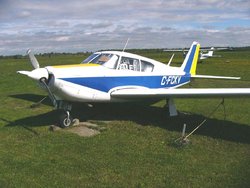Piper PA-24 Comanche
|
|
The Piper PA-24 Comanche is a four-seat light utility aircraft first launched in 1957. It is a low-wing, all-metal aircraft with retractable landing gear. Together with the twin-engine version of the same airframe, the Twin Comanche, it made up the core of the Piper aircraft line-up until 1972 when the production lines for both aircraft were wiped out in a flood. At that time Piper had already begun to concentrate on its successful 140/180 and Cherokee line, which were in fact originally conceived as cheaper alternatives to the increasingly expensive Commanche. The original version featured a 180 hp (134 kW) Lycoming 0-360 engine, swept tail, laminar flow wing, and stabilator. Reportedly designed by Howard "Pug" Piper himself, the Comanche was intended to compete in the market with the successful Beechcraft Bonanza.
The following year Piper released a 250 hp (187 kW) version using a Lycoming 0-540 engine, giving the Comanche a cruise speed of 185 mph (296 km/h). Later versions of the Comanche were the 260 hp (194 kW) Lycoming IO-540 version and the Comanche 400, which featured the very powerful 8-cylinder Lycoming IO-720 engine under the cowl, developed specifically for the Commanche. High insurance premiums and engine cooling problems (as the rear two cylinders received poor airflow) resulted in a limited production run for this somewhat rare aircraft.
It is reported that Pug Piper made many of his design choices based on existing aircraft. The laminar flow wing was a feature found on the P-51 Mustang fighter. The swept tail was evocative of the current fighter aircraft, and the stabilator (flying tail) was a prominent feature of the Bell X-1, the first aircraft to break the sound barrier. The Comanche was a popular model and is still appreciated for its attractive lines.
Factory-installed auxiliary fuel tanks in the wings gave the Comanche a fuel capacity of 90 US gallons (341 litres) and a respectable range of nearly 1,125 miles (1,800 km) for some models. Later, the J.L. Osborne Company produced a wingtip fuel tank modification that gave the Comanche an extra 30 US gallons (113 litres) of fuel. With the 250 and 260 models burning roughly 15 US gallons (56.5 litres) per hour at sea level, the mid-model Comanches have an impressive range.
Stable flight characteristics made the Comanche a popular airplane for IFR (Instrument Flight Rules) flying. Dual Nav/Com radios and an optional auto-pilot made long-distance flying comfortable.
Perhaps the most impressive display of the Comanche's performance and economy was the record breaking long distance flight of Max Conrad in a Comanche 250 in June 1959. Having removed the interior seats and replaced them with fuel tanks, Conrad flew non-stop from Casablanca, Morocco to Los Angeles, a distance of 7,668 miles (12,268 km). When the aircraft took off from Casablanca, it was loaded 2,000 pounds (909 kg) over its production gross weight limit, demonstrating the ruggedness of the Piper design.
Production of the Comanche ended in 1972 after a flood in the manufacturing plant destroyed the tooling necessary for production. Rather than re-build the tooling, Piper chose to move on with newer designs such as the Saratoga.
Today, however, the Comanche remains popular in the used aircraft market. The 250 and 260 models especially are respected as economical machines which perform well. Comanche owners remain loyal fans, and the aircraft's aircraft type club The International Comanche Society, hosts fly-ins, prints a monthly magazine, and offers training specific to the model.
In 1967 a single Comanche was modified by Swearingen to pressurize the cabin. Designated the PA-33, it was decided not to put this aircraft into production.
External Link
- The International Comanche Society (http://www.comancheflyer.com/)
|
Lists of Aircraft | Aircraft manufacturers | Aircraft engines | Aircraft engine manufacturers Airports | Airlines | Air forces | Aircraft weapons | Missiles | Timeline of aviation |

